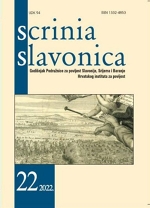POSLJEDNJE GODINE I SMRT FERDE ŠIŠIĆA (1938. – 1940.)
The Last Years and the Death of Ferdo Šišić (1938-1940)
Author(s): Matko GlobačnikSubject(s): Cultural history, Political history, Social history, Interwar Period (1920 - 1939)
Published by: Hrvatski institut za povijest
Keywords: Ferdo Šišić; Croatian historiography; interwar period; Kingdom of Yugoslavia; intellectual history; political history; institutional history;
Summary/Abstract: This paper provides a more detailed analysis of the scholarly, cultural and political activities of the distinguished Croatian historian Ferdo Šišić during the last years of his life from 1938 to 1940. The main objective has been to cast light on the relation of Šišić’s work in the field of historiography and his political activities in the historical context defined by the institutions of the Kingdom of Yugoslavia at the time. The first chapter refers to Šišić’s withdrawal from his teaching duties at the Faculty of Philosophy in Zagreb in the academic year 1937/38 due to a heart condition and to political conflicts among the students at Zagreb University. His activities in Masonic lodges have been explored and his actions published in early 1938 analysed; they clearly indicated his close relations to the regime in Belgrade and to the policy of the then Prime Minister Milan Stojadinović. Another focus of the paper is Šišić’s publications published in spring 1938 particularly in reference to the re-establishment of his cooperation with Matica hrvatska, which, administered by Filip Lukas, became the base of activities for Croatian nationalist intellectuals with a negative attitude towards the regime in Belgrade. A thorough analysis of Šišić’s works, primarily in journalist style, published under changing political circumstances after the fall of Prime Minister Stojadinović’s government in the first half of 1939, has provided a clear indication of Šišić’s opportunism and careerism as the most acceptable explanation for his political and cultural activities. However, in this paper close attention has been also drawn to Šišić’s huge energy for work which, despite his poor health condition, made him return to his teaching duties at the Faculty of Philosophy in Zagreb in the winter semester of the academic year 1938/39; with this energy he maintained relationships with numerous colleagues and associates and continued writing, publishing a great number of works. This was partly also the reason why his seventieth birthday in March 1939 had a major impact, especially among the well-informed. The last part of this paper investigates Šišić’s life in the second half of 1939 marked by the progress of his illness, his retirement and the withdrawal from public life, which took place in the context of the establishment of the Banovina of Croatia. The final part describes Šišić’s death and his funeral in January 1940, special attention being paid to the first reviews of Šišić’s life and work immediately after his death.
Journal: Scrinia Slavonica
- Issue Year: 2022
- Issue No: 22
- Page Range: 211-246
- Page Count: 36
- Language: Croatian

